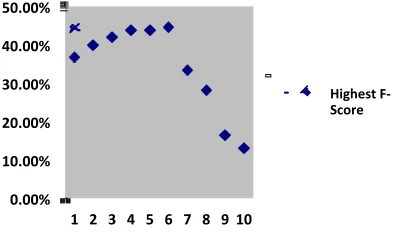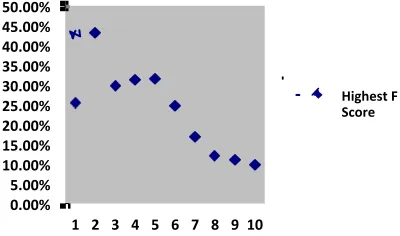Distractorless Authorship Verification
John Noecker Jr1, and Michael Ryan1
1Evaluating Variations in Language Laboratory, Duquesne University, Pittsburgh, Pennsylvania, USA {jnoecker,mryan}@jgaap.com
Abstract. Authorship verification is the task of, given a document and a candidate author, determining whether or not the document was written by the candidate author. Traditional approaches to authorship verification have revolved around a “candidate author vs. everything else” approach. Thus, perhaps the most important aspect of performing au-thorship verification on a document is the development of an appropriate distractor set to represent “everything not the candidate author”. The validity of the results of such experiments hinges on the ability to develop an appropriately rep-resentative set of distractor documents. Here, we propose a method for performing authorship verification without the use of a distractor set. Using only training data from the candidate author, we are able to perform authorship verifica-tion with high confidence (greater than 90% accuracy rates across a large corpus).
Keywords. Authorship verification, authorship attribution, corpus linguistics, computational stylometry.
1
Introduction
In traditional authorship attribution, our task is to as-sign an author label (or a similar categorical label such as genre, publication date, etc.) to a work of unlabeled au-thorship. In the closed-set problem, we assign a label from a set of potential authors for whom we have some labeled training data. In the open-set problem, we also allow for the answer “none of the above”. We build upon this here with the authorship verification task, which is essentially an open-class authorship attribution problem with only one author in the candidate pool. Thus for a given docu-ment D and candidate author A, we attempt to answer the question “Was D written by A?”.
2
Background
Previous approaches to this problem [1-2] have in-volved the creation of a distractor set, which is normally controlled for genre, tone, length, etc. and performing an a traditional authorship attribution-style analysis to see whether the unlabeled document is more likely to be by the candidate author or one of the authors in the distractor set. This approach is not ideal because it relies heavily on the creation of an appropriate distractor set. That is, enough information was available about the candidate author and the training documents to choose a set of dis-tractor authors that were appropriate for the task. Thus, although these methods performed well at the verification task, they do not lend themselves well to automation. Indeed, the entire result of this type of authorship verifica-tion hinges upon the documents chosen for the distractor set. This creates a sort of chicken-and-egg problem where-in it is necessary to know the answer where-in order to evaluate the suitability of the distractor set, yet it is necessary to
know whether the distractor set is appropriate in order to evaluate the results.
We will attempt to remedy the errors introduced by the distractor set by eliminating the set entirely. Instead, we will consider only the document in question as well as a sample of writing known to belong to the candidate au-thor. Thus, the validity of the verification task hinges only on obtaining a representative model of the candidate au-thor’s work, a requirement shared by traditional verifica-tion tasks, and does not involve any guesswork.
3
Materials and Methods
3.1 Distractorless Authorship Verification
Goal: Given a document D, and a candidate author A, determine the likelihood that D is written by A.
Method:
1.Compile a set of training data, which is known to be written by A.
2.Compile a model from the training data. This is nor-mally accomplished by extracting linguistic or token-level features from the text and compiling a feature vector using any of various standard techniques from the authorship attribution field. We will label this fea-ture vector M = <m1, m2, …, mn>.
3.Extract a feature set, F, from D in the form of F = <f1, f2, …, fn>, where ficorresponds to mifor all i.
4.Choose a “distance like” function, δ, such that if δ(x, y) > δ(x, z), we can say that x is “closer to” or “more simi-lar to” y than to z (in some meaningful way).
to answer the verification task, we need only consider the dot product of the unknown document with the candidate author model. So, let:
𝛿 𝑀,𝐹 = 𝑀∙𝐹 𝑀 𝐹 =
𝑚!𝑓! ! !!!
𝑚!! 𝑓
!! ! !!! !
!!!
4
Results
4.1 AAAC Corpus Results
Characters
For the AAAC Corpus with character n-grams, we achieved our best results using Character 12-grams. Our highest accuracy was 87.44% and our highest F-Score was 47.12%. These results were achieved by setting a threshold, t, of t=0.099387 and t = 0.001597 respectively. For character n-grams of various values of n, our best accuracies varied from about 86% to about 88%, while our best F-Scores varied from 37% to 47%, as shown in Figures 1 and 2.
Fig. 1. AAAC Character n-grams by Highest F-Score
Fig. 2. AAAC Character n-grams by Highest Accuracy
Words
For the AAAC Corpus with word n-grams, we achieved our best results using Word 4-grams. Our highest accura-cy was 88.04% and our highest F-Score was 44.58%. These results were achieved by setting a threshold, t, of t=0.006923 and t = 0.000029 respectively. For word n-grams of various values of n, our best accuracies varied
from about 86% to about 88%, while our best F-Scores varied from 37% to 45%, as shown in Figures 3 and 4.
Fig. 3. AAAC Word n-grams by Highest F-Score
Fig. 4. AAAC Word n-grams by Highest Accuracy
4.2 PAN Corpus Results
Characters
For the PAN Corpus with character n-grams, we achieved our best results using Character 7-grams. Our highest accuracy was 92.23% and our highest F-Score was 51.35%. These results were achieved by setting a threshold, t, of t = 0.1643 and t = 0.1707 respectively. For character n-grams of various values of n, our best accura-cies varied from about 90% to about 92%, while our best F-Scores varied from 20% to 51%, as shown in Figures 5 and 6.
0.00% 5.00% 10.00% 15.00% 20.00% 25.00% 30.00% 35.00% 40.00% 45.00% 50.00%
Highest F-‐ Score
85.80% 86.00% 86.20% 86.40% 86.60% 86.80% 87.00% 87.20% 87.40% 87.60%
Highest Accuracy
0.00% 10.00% 20.00% 30.00% 40.00% 50.00%
1 2 3 4 5 6 7 8 9 10
Highest F-‐ Score
85.00% 85.50% 86.00% 86.50% 87.00% 87.50% 88.00% 88.50%
1 2 3 4 5 6 7 8 9 10
Fig. 5. PAN Character n-grams by Highest F-Score
Fig. 6. PAN Character n-grams by Highest Accuracy
Words
For the PAN Corpus with word n-grams, we achieved our best results using Word 2-grams. Our highest accuracy was 91.53% and our highest F-Score was 43.08%. These results were achieved by setting a threshold, t, of t = 0.1518 and t = 0.1078 respectively. For word n-grams of various values of n, our best accuracies varied from about 90% to about 92%, while our best F-Scores varied from 10% to 43%, as shown in Figures 7 and 8.
Fig. 7. PAN Word n-grams by Highest F Score
Fig. 8. PAN Word n-grams by Highest Accuracy
5
Discussion and Conclusion
These results are as expected, and show that distractor-less authorship verification is a viable technique with high accuracy even on extremely difficult problems. The lower accuracy rates on the AAAC Corpus are expected, as this corpus contains many times more authors than the PAN corpus with fewer training documents per author. Despite this, we were able to achieve accuracy rates of up to 88% on this more difficult corpus, and 92% on the “easier” PAN corpus.
It should be noted that the results of this technique are extremely tunable. For instance, we can tune for any com-bination of accuracy, precision, recall and F-Score, as desired. That is, this distractorless authorship verification technique allows us to tune the Type I vs. Type II error rates depending on the application of the technology. For instance, in a forensic context we may want to err on the side of saying “no”, and thus prefer to reduce false posi-tives, while in a less stringent application we may wish to improve the overall accuracy at a cost of possibly having more false positives.
Given the performance on both the PAN corpus, which consisted mainly of real-life e-mail messages, and the AAAC corpus, which contained a wide variety of docu-ments, the distractorless authorship verification technique shows promise for a wide range of genres and document lengths, and appears to work across a variety of lan-guages, all without much tuning. Indeed, the only difficul-ty appears to be in finding an appropriate threshold, t, for given candidate author. This is possible by analyzing the average δ between documents by the candidate author. It can also be approximated from a large corpus, as was done here, although these results make it clear that there will be some of the same problems in controlling the cor-pus for genre, document length, etc. that were present in forming a distractor set for traditional authorship verifica-tion.
Future work will focus on improving these results, mainly through the addition of confidence ratings for the verification answers. That is, by allowing the system to decline to answer some percentage of the verification
0.00% 10.00% 20.00% 30.00% 40.00% 50.00% 60.00%
Highest fScore
88.50% 89.00% 89.50% 90.00% 90.50% 91.00% 91.50% 92.00% 92.50%
Highest Accuracy
0.00% 5.00% 10.00% 15.00% 20.00% 25.00% 30.00% 35.00% 40.00% 45.00% 50.00%
1 2 3 4 5 6 7 8 9 10
Highest F Score
89.00% 89.50% 90.00% 90.50% 91.00% 91.50% 92.00%
1 2 3 4 5 6 7 8 9 10
questions asked (or, effectively, to answer “I don’t know”), we have seen some improvement in these exper-imental results. Although full results for this study are not yet available, we have seen that by dropping the 20% “most difficult” verification problems, we see an increase in accuracy to approximately 96% (from 92% on the strict binary problem). Whether or not this is truly an increase in accuracy depends upon the intended application of the technology, but we believe this future work will provide interesting results in application-specific tradeoffs, as described above.
Overall, we believe we have shown this distractorless authorship verification to be a useful tool on the sty-lometrist’s workbench. Although no tool is itself a pana-cea, we are also planning efforts to combine this tech-nique with a mixture-of-experts style voting system, ef-fectively using multiple distance functions and feature sets on the same problem to increase confidence in our answer. Finally, we hope to both more fully explore the process of determining the appropriate threshold without the need for extraneous texts, and to find an acceptable “default” threshold for cases where there is little training data. We have found enough similarity in the highest ac-curacy and highest F-Score thresholds that we believe a threshold point may exist that, despite being slightly less accurate than application-specific thresholds, will perform adequately across a wide range of documents.
6
References
1. Koppel Moshe and Jonathan Schler, "Authorship Verifica-tion as a One-Class ClassificaVerifica-tion Problem", ICML '04 Pro-ceedings of the Twenty-First International Conference on Machine Learning., 2004, New York, NY
2. Koppel Moshe and Jonathan Schler, "Text Categorization for Authorship Verification", 8th Symposium on Artificial Intelligence, 2004.
3. Juola, Patrick. (2004). "Ad-Hoc Authorship Attribution Competition" ALLC/ACH 2004 Conference Abstracts. Gothenberg: University of Gothenberg.
4. PAN 2011 Lab: Uncovering Plagiarism, Authorship, and Social Software Misuse. Authorship Identification Training Corpus. Amsterdam, 2011.
5. Enron Email Dataset. http://www.cs.cmu.edu/~enron/ 6. Juola, Patrick and Michael Ryan,. Authorship Attribution,
Similarity, and Noncommutative Divergence Measures. In Selected Papers from the Chicago DHCS Colloquium. 2008. Chicago, IL,: Chicago Colloquium on Digital Hu-manities and Computer Science.


